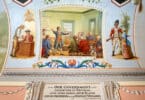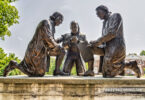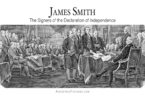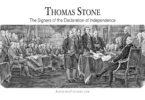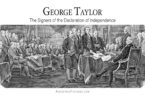John Penn was born in May of 1741 in Port Royale, Caroline County, Virginia. He was the only child of his parents, Moses Penn and Catherine Taylor. Like so many of the signers of the Declaration of Independence, his name has been largely forgotten to history, eclipsed by the historical fame of a relative few others of the signers. This does not mean he was any less accomplished in life than they were. Also, this John is not to be confused with the John Penn who was the grandson of Pennsylvania founder William Penn. John the signer came from a different Penn family whose origins in America are not known.
John Penn is notable for several projects in which he was involved. Not only was he a signer of the Declaration of Independence, but he also signed the Articles of Confederation, served for six years on the Continental Congress, signed the North Carolina state constitution, and was the unquestioned and almost dictatorial leader of North Carolina at its most pivotal point during the American Revolution in the period spanning 1871 to 1782.
Before all of this, though, John was a simple student at the local common school as a child, as his dad did not believe that education was important. So, John just received a basic education as a child. In fact, he only attended the common school for two years. At age eighteen, all of that simple lifestyle changed for John. His father crossed over to the other side, and he was suddenly left with the responsibility of caring for the family’s lands, as well as for providing for his widowed mom. Suddenly, John, for the first time in his life, realized the value of education.
John’s uncle, Edmund Pendleton, was an attorney, an accomplished one, and he took young John under his wing. In fact, Edmund was described by Thomas Jefferson as the “greatest orator” in the colonies, and also wrote George Washington’s will for him shortly before Washington was appointed as the Commander in Chief of the Continental Army. Both Thomas Jefferson and John Adams described Edmund’s personal library as being the finest one in the colonies, and John availed himself of the opportunity to study there. John studied law under his uncle and became a lawyer in Virginia in 1762. John practiced law for the rest of his life.
John married Susanna Lyne in July of 1763. They had three children together, two of whom survived past childhood. Susanna’s family came to America in 1635 and dated in England back to the Norman Conquest.
While practicing law in Virginia and raising his family there, several of John’s relatives moved to Granville County, North Carolina. John followed them there in 1774, moving there with his wife and kids. They settled in the Williamsboro area of the colony. Besides family moving there, it appears as if there were other reasons for the move. John had been charged with disrespectful and possibly treasonous remarks about the king earlier in the year that he moved. These comments were made in opposition to the colonies being taxed without representation, and he wanted redress of this grievance or immediate independence of the colonies due to this situation with Great Britain. Though John had only been fined a penny for the offense, as his trial had been preceded over by a friendly judge, he refused to pay it on principle, which made him stand out even more as a possibly seditious person in Virginia.
Granville County in North Carolina was the perfect place for this kind of revolutionary radical at the time. The place had attracted others of the same mindset, who wanted liberty for the colonies rather than reconciliation with Great Britain. After arriving in Granville, John found several local issues of concern to him. The most important ones, to him, were the local restrictions and unfairness of British rule in the colony, and the unfair treatment of smaller farmers, artisans, and others by the county’s wealthy plantation owners and merchants, who dominated local government.
A man like John could not abide by these things. The locals in Granville easily accepted him, and soon looked to him as a leader. He set up a law practice there, became incredibly popular with the locals, and was selected to represent the county at the First Continental Congress. John was also elected to the North Carolina Provincial Congress. This did not please the influential people who were part of the eastern North Carolina establishment, as they believed John was an intruder to their county and a threat to their power and influence.
When he arrived at the Continental Congress, after first taking care of some business in the Provincial Congress, John said, “My first wish is for America to be free.” The Provincial Congress back home authorized him and other delegates from the colony to support the cause of American freedom from Great Britain.
In 1820, Thomas Jefferson wrote to John Adams, recalling John’s role in the debate on independence at the Continental Congress. Jefferson said that of North Carolina’s three delegates, one was a staunch Royalist, one went back and forth on his wishes concerning independence, and John was the one who was totally committed to the independence issue. In fact, it was John, according to Jefferson, who convinced the wishy-washy delegate to vote for independence, and the Royalists to abstain, so that the Declaration of Independence may be adopted by Congress. Though there was one abstention in the North Carolina delegation on the vote, all three members signed the Declaration once it was adopted.
John served on the Continental Congress for a phenomenal six years, from 1775 to 1781, going back and forth between Philadelphia and his home in North Carolina quite a bit. It was a long, grueling trip of four hundred miles that took two weeks on horseback or stagecoach to make, and the trip was filled with a variety of hazards and hardships, such as thieves on the highway, flea-infested inns, bad food, bad weather, and more. It is no wonder then, that John was in poorer health when he finally returned home for good than he was when he left. He resumed his law practice when he came home from the Congress, enjoyed America winning its independence in 1783, and crossed to the other side in 1788. The hardships of serving on the Congress took many signers to the other side when they were still relatively young, and John was one of them.
Initially, John was buried on the property of his family’s home in Granville County. In April of 1894, he was moved to the Signers Monument near the statue of Nathaniel Greene at the Guilford Courthouse National Military Park. At least one other North Carolina Declaration signer (the Royalist) is buried there, too. At the moving of the state’s signers, an elaborate ceremony was given to them.


